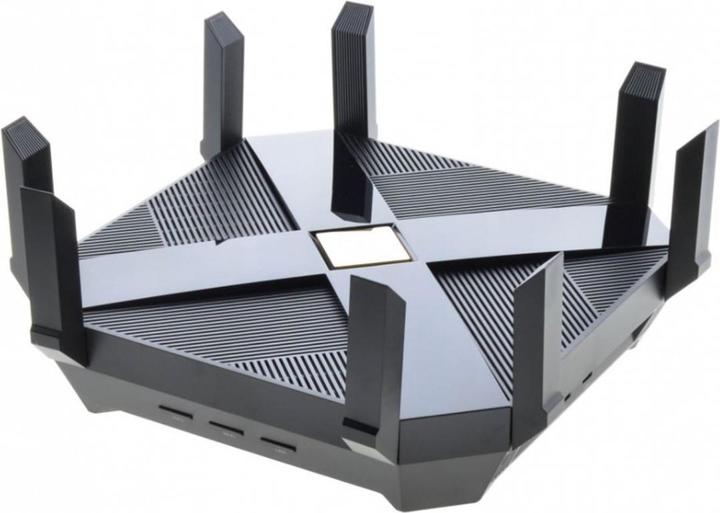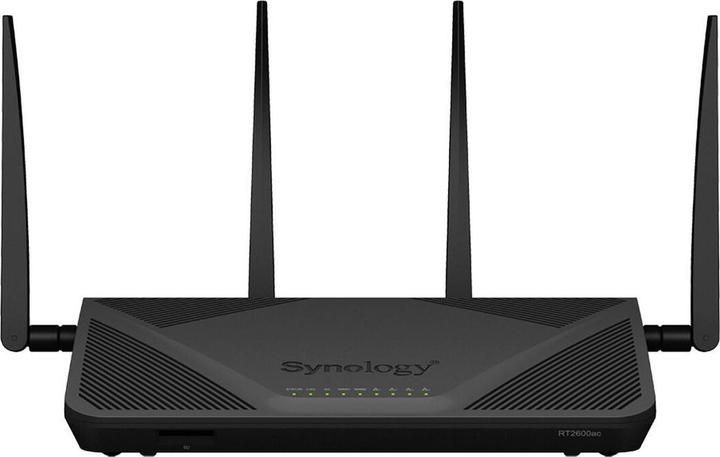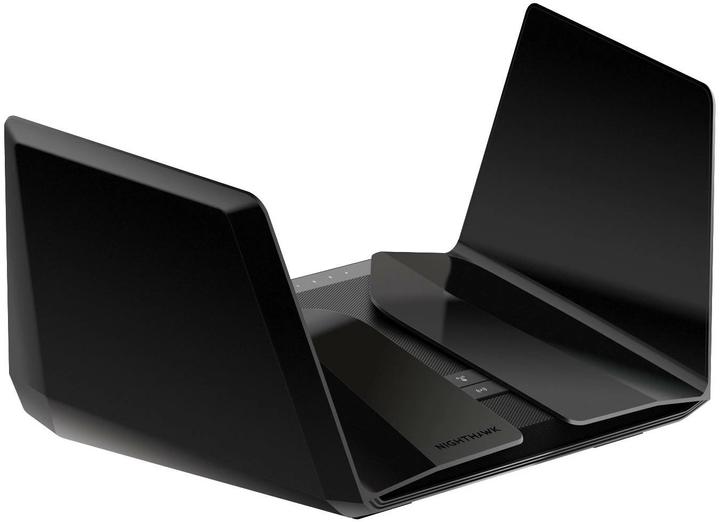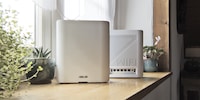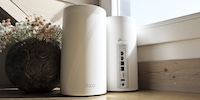

Speed testing the Dream Machine
The Ubiquiti UniFi Dream Machine reportedly performs well despite its compact design. As noted both on Reddit, and by user comments in our shop. But is this router actually good for something, or is the only impressive thing about it its sleek cylindrical design? Our speed test will reveal all.
The Dream Machine may not yet have Wi-Fi 6, but it does have a good reputation. It's often showered with praise in internet forums, in our shop it's rated as good. And user xazax demanded a speed comparison in a recent comment. Reason enough to take a closer look at this nifty little device.
In the UniFi Dream Machine, Ubiquiti combines its basic components – access point, cloud key, security gateway and switch. It should be easy to combine with other UniFi products. You can add network cameras or expand your Wi-Fi into a mesh network.

The technical details:
- Processor and memory: 1.7 GHz quad-core processor (Arm Cortex-A57), 16 GB of flash memory, 2 GB of RAM.
- Antennas: Internal dual band antenna with quadruple polarity.
- Ports: 1 x RJ45 WAN (Gigabit), 4 x RJ45 LAN (Gigabit).
- 5 GHz network standards: IEEE 802.11ac/ac-wave2/a/n.
- 2.4 GHz network standards: IEEE 802.11a/n/b/g.
- Transmission rate: 5 GHz to 1733 Mbps, 2.4 GHz to 300 Mbps.
- Encryption: WEP, WPA-PSK, WPA-Enterprise (WPA/WPA2, TKIP/AES).
- DHCP modes: Server, relay, switched off.
- Dimensions: Ø 110 x 184.2 mm, 1.05 kg.
- Operation: Reset button.
- Features: Beamforming, MU-MIMO, IDS/IPS, DPI, 802.11w/PMF, WMM, DFS, Advanced QoS, VLAN, Power Save, Guest Traffic Isolation and more.
Apartment floor plan and router location
I install the Dream Machine in my 120 m² maisonette. The best Wi-Fi device I've tested so far in this flat is by TP-Link. Their router, the Archer AX6000 leads the pack with an average of 405.32 Mbps, 3 ms of ping and a signal strength of -62 dBm.


Setting up the router
I like the HomePod design of this router. You get one WAN and four LAN ports. Plus a reset button and a mains connection – the power supply unit is integrated in the product.

When you turn on the Dream Machine, it sounds like a low-power hair dryer for a short time. The fan fires up and blows any dust out of the case. After a few seconds there is silence – I never notice the fan in operation. A bright white LED ring continues to pulse during the boot process. When the device is ready for use, the LED changes to a static blue. You also hear a jingle, which reminds me of a train announcement or a Brother printer.
The initial setup of the router is done quickly:
- Connect a PC or other terminal device to the router via a LAN cable or Wi-Fi. The router has open WLAN, SSID initialises with a UDM setup.
- Open a browser and visit setup.ui.com. If necessary, an insecure connection must be accepted before the router can be set up.
- Follow the setup.

During setup, aside from setting up a new Wi-Fi source, an ubiquiti account must also be created. The product can't be used without one.

What's surprising about Ubiquiti are the many settings and options that are offered after the initial setup. This gives pro users a chance to let off steam. Beginners on the other hand require some patience and Google.
Speed, ping and signal strength per room
Armed with a notebook and software, I measure the Dream Machine's Wi-Fi. I measured the new installation with a Wi-Fi-6-capable notebook and the «LAN Speed Test» app. I uploaded a 1 GB file to my NAS (article in German), which is located in the living room, three times in total. Then I determined the latency of the DOS console by pinging my NAS. For the signal strength, which is specified in decibel milliwatts (dBm), I used the «NetSpot» software.
As a reminder, a higher value means better signal strength. While values between -35 and -55 dBm near a router provide a good signal, values of -75 dBm or less in distant corners correspond to a weak signal.
Results
This is how the Ubiquiti UniFi Dream Machine performs:
| Location | 5 Ghz frequency speed / ping / signal strength | 2.4 Ghz frequency speed / ping / signal strength |
|---|---|---|
| Entrance hall | 470,40 Mbps / 3 ms / -66 dBm | 48,80 Mbps / 5 ms / -63 dBm |
| Living room | 603,20 Mbps / 2 ms / -44 dBm | 88,80 Mbps / 4 ms / -42 dBm |
| Dining room | 586,40 Mbps / 3 ms / -61 dBm | 63,68 Mbps / 5 ms / -54 dBm |
| Kitchen | 548,00 Mbps / 3 ms / -60 dBm | 50,80 Mbps / 5 ms / -48 dBm |
| Balcony | 451,20 Mbps / 3 ms / -71 dBm | 41,92 Mbps / 5 ms / -64 dBm |
| Broom closet | 409,60 Mbps / 4 ms / -64 dBm | 44,32 Mbps / 6 ms / -64 dBm |
| Bathroom | 597,60 Mbps / 3 ms / -50 dBm | 85,60 Mbps / 5 ms / -54 dBm |
| Office | 279,20 Mbps / 5 ms / -75 dBm | 34,88 Mbps / 6 ms / -66 dBm |
| Washing room | 382,40 Mbps / 4 ms / -77 dBm | 33,76 Mbps / 7 ms / -68 dBm |
| Upstairs bathroom | 373,60 Mbps / 4 ms / -70 dBm | 49,84 Mbps / 5 ms / -64 dBm |
| Bedroom | 282,40 Mbps / 4 ms / -73 dBm | 43,76 Mbps / 5 ms / -61 dBm |
| Ø | 453,09 Mbps / 3 ms / -65 dBm | 53,28 Mbps / 5 ms / -59 dBm |
The average speed of the Dream Machine at 5 GHz is 453.09 Mbps, almost 50 Mbps higher than our previous king, the TP-Link Archer AX6000 (Ø 405.32 Mbps). In terms of latency, both routers even out at 3 ms. On the other hand, Ubiquiti's 2.4 GHz frequency band is surprisingly slow and only reaches 53.28 Mbps. The Archer destroys it with 141.68 Mbps and its eight antennas.
Another unusual thing about the new winner is that the 5 GHz signal strength averaging -65 dBm is 3 dBm worse than its TP-Link competition. In an environment with many interfering signals, TP-Link should therefore have a slight advantage. The following heat maps show my signal strength measurement in detail.
5 GHz heat map
The lower the measured dBm value, the worse the signal strength and the more blue the colour.



2.4 GHz heat map
The 2.4 GHz frequency band has a higher range, but lower speeds.



Comparison with the competition
A comparison with the four fastest devices tested so far in my apartment gives us the following picture:
| Location | Ubiquiti UniFi Dream Machine (Wi-Fi 5) | TP-Link Archer AX6000 (Wi-Fi 6) | Synology RT2600ac (Wi-Fi 5) | Netgear RAX120 Nighthawk (Wi-Fi 6) | ROG Rapture GT-AC2900 (Wi-Fi 5) |
|---|---|---|---|---|---|
| Entrance hall | 470,40 Mbps / 3 ms / -66 dBm | 457,23 Mbps / 3 ms / -62 dBm | 484,1 Mbps / 4 ms | 420,73 Mbps / 3 ms | 283,0 Mbps / 3 ms |
| Living room | 603,20 Mbps / 2 ms / -44 dBm | 545,69 Mbps / 2 ms / -44 dBm | 551,2 Mbps / 2 ms | 407,81 Mbps / 2 ms | 553,6 Mbps / 2 ms |
| Dining room | 586,40 Mbps / 3 ms / -61 dBm | 486,73 Mbps / 3 ms / -50 dBm | 548,0 Mbps / 2 ms | 359,68 Mbps / 3 ms | 520,0 Mbps / 2 ms |
| Kitchen | 548,00 Mbps / 3 ms / -60 dBm | 479,59 Mbps / 3 ms / -57 dBm | 434,4 Mbps / 3 ms | 415,89 Mbps / 3 ms | 388,0 Mbps / 2 ms |
| Balcony | 451,20 Mbps / 3 ms / -71 dBm | 434,88 Mbps / 3 ms / -68 dBm | 391,2 Mbps / 3 ms | 331,70 Mbps / 4 ms | 284,0 Mbps / 3 ms |
| Broom closet | 409,60 Mbps / 4 ms / -64 dBm | 429,07 Mbps / 4 ms / -64 dBm | 312,8 Mbps / 6 ms | 356,46 Mbps / 3 ms | 373,6 Mbps / 2 ms |
| Bathroom | 597,60 Mbps / 3 ms / -50 dBm | 476,04 Mbps / 3 ms / -49 dBm | 549,3 Mbps / 4 ms | 430,81 Mbps / 3 ms | 523,2 Mbps / 2 ms |
| Office | 279,20 Mbps / 5 ms / -75 dBm | 254,51 Mbps / 4 ms / -73 dBm | 176,8 Mbps / 7 ms | 248,61 Mbps / 3 ms | 56,9 Mbps / 5 ms |
| Washing room | 382,40 Mbps / 4 ms / -77 dBm | 328,22 Mbps / 4 ms / -75 dBm | 242,4 Mbps / 4 ms | 235,20 Mbps / 3 ms | 193,0 Mbps / 4 ms |
| Upstairs bathroom | 373,60 Mbps / 4 ms / -70 dBm | 321,52 Mbps / 4 ms / -70 dBm | 297,6 Mbps / 6 ms | 270,96 Mbps / 4 ms | 269,0 Mbps / 3 ms |
| Bedroom | 282,40 Mbps / 4 ms / -73 dBm | 245,06 Mbps / 4 ms / -74 dBm | 226,4 Mbps / 6 ms | 220,41 Mbps / 4 ms | 179,0 Mbps / 4 ms |
| Ø | 453,09 Mbps / 3 ms / -65 dBm | 405,32 Mbps / 3 ms / -62 dBm | 383,1 Mbps / 4 ms | 336,21 Mbps / 3 ms | 329,4 Mbps / 3 ms |
Conclusion: not just a pretty face
Ubiquiti's Dream Machine offers speedy connections and, considering the lack of external antennas, surprisingly good coverage. But our new speed test king doesn't only deserve a crown because of an impressive result and a beautiful appearance. There is much room for expansion, especially with regard to mesh. The variety and depth of options might be somewhat daunting for beginners – others don't like having a Ubiquiti account or are put off by the rather high price.
The only real disadvantage I notice is in the slow 2.4 GHz frequency band and a lack of features that Wi-Fi-6 would bring.
Finally, my new Top 5:
1. The Ubiquiti UniFi Dream Machine, with an average of 453.09 Mbps, 3 ms latency and -65 dBm
2. The TP-Link Archer AX6000, with an average 405.32 Mbps, 3 ms latency and -62 dBm.
3. The Synology RT2600ac, with an average of 383.1 Mbps and 4 ms latency.
4. The Netgear RAX120 Nighthawk, with an average of 336.21 Mbps and 3 ms latency (in terms of range, this router ranks second).
5. The Asus ROG Rapture GT-AC2900, with an average of 329.4 Mbps and 3 ms latency.
I find my muse in everything. When I don’t, I draw inspiration from daydreaming. After all, if you dream, you don’t sleep through life.
